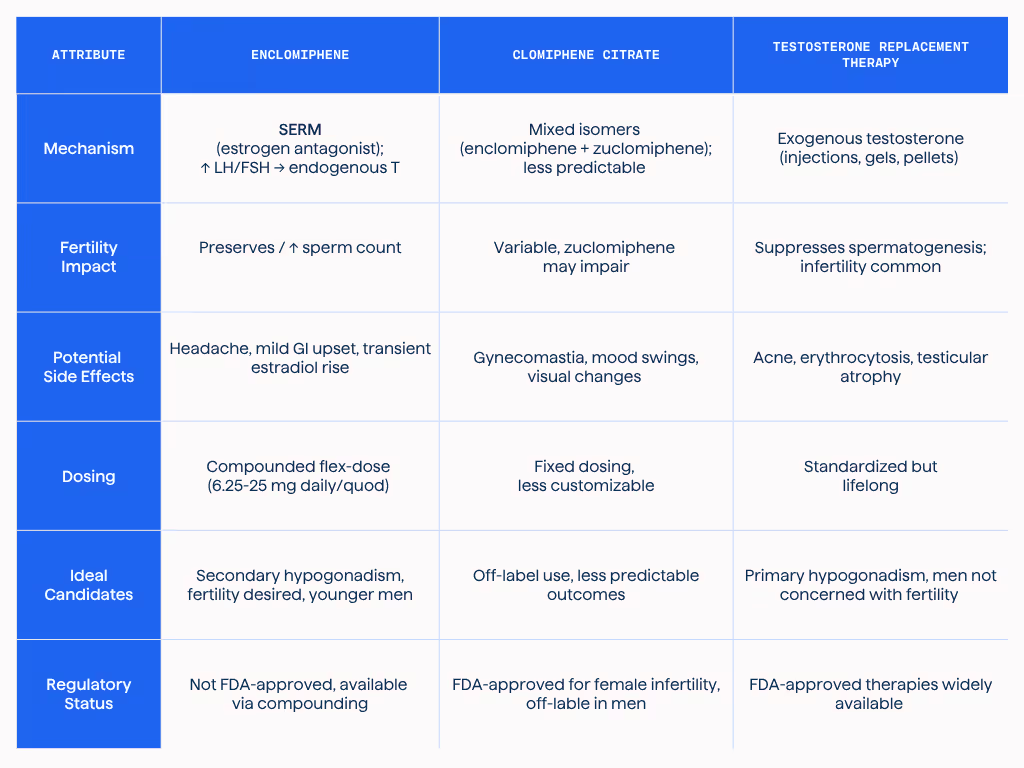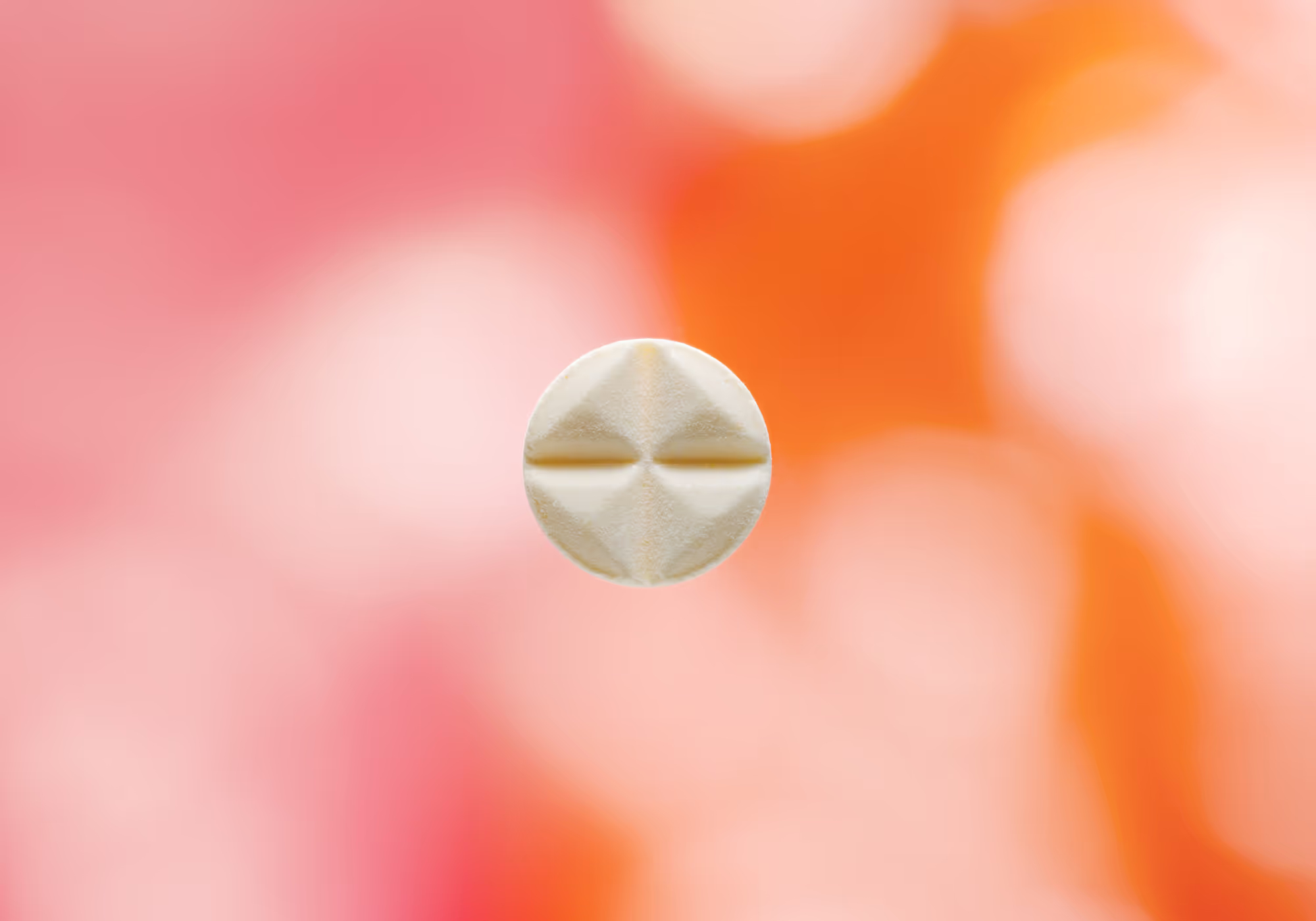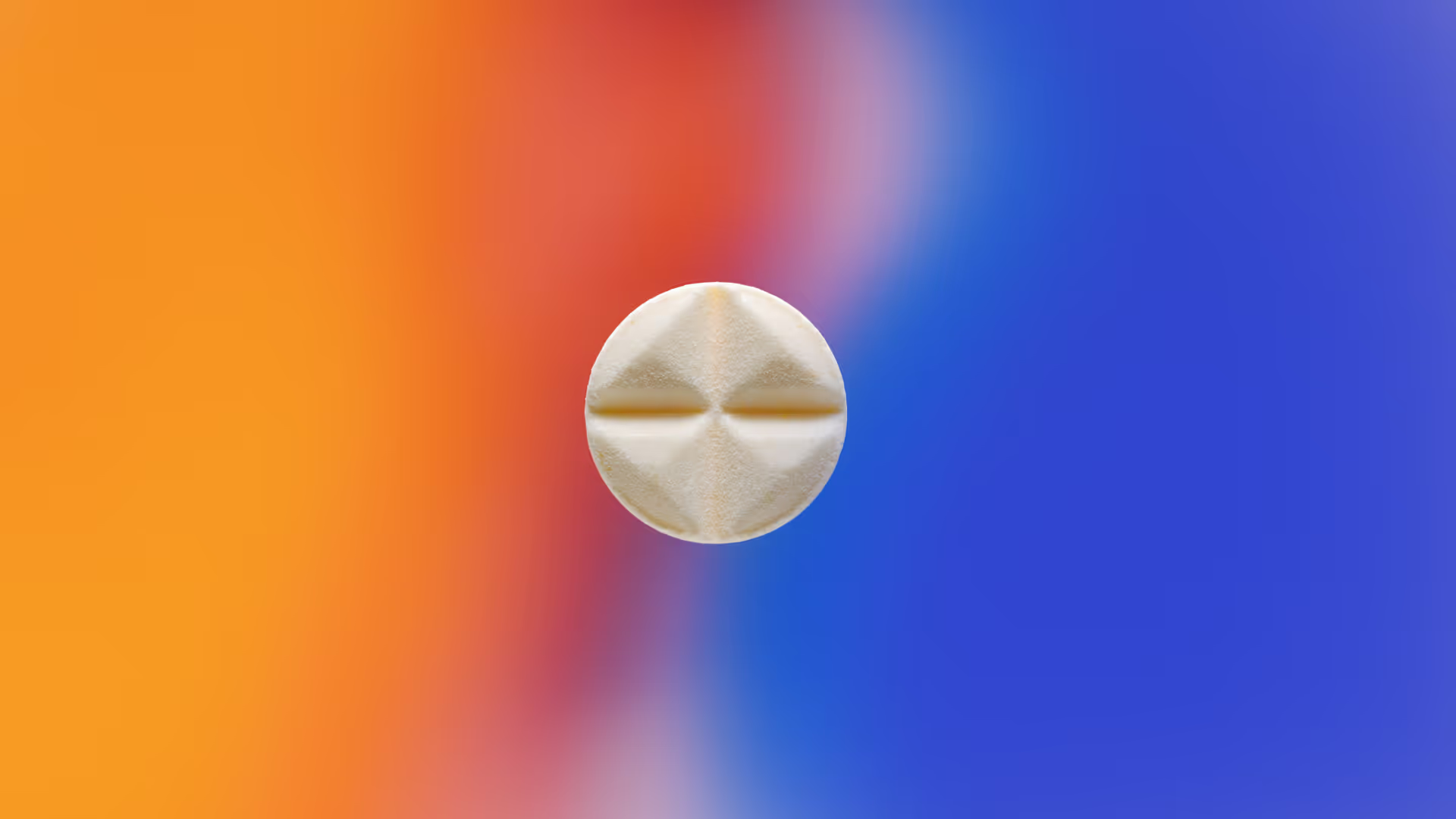Enclomiphene: Help Restore Testosterone & Fertility in Men
Need To Knows:
• A Third Path Forward
Traditional testosterone care often forces a choice: boost testosterone but sacrifice fertility, or protect fertility but live with low testosterone. Enclomiphene breaks that old binary and stabilizes natural production while helping to preserve fertility.1
• Restoration, Not Replacement
Unlike testosterone replacement therapy (TRT), which shuts down the body’s own reproductive processes, enclomiphene stimulates them. The result may be normalized testosterone and long-term hormonal balance.2
• Clinical Edge
Studies have shown that enclomiphene can maintain sperm counts, support metabolic health, and minimize side effects. Enclomiphene offers a modern and fertility-friendly alternative to conventional therapies.3
Modernizing Men’s Testosterone Treatment
The old script left men in a double bind: accept decline, or trade vitality for fertility through testosterone replacement. That all-or-nothing approach is outdated. Enclomiphene flips the script by opening up a third path — one that restores the body’s own testosterone production while protecting fertility. No compromises. No outdated tradeoffs.
The Old Catch-22:
- Testosterone replacement therapy: Raises serum testosterone but suppresses fertility, may lead to shrinking testes, and can create lifelong dependency.1
- Doing nothing: May leave men with fatigue, low libido, metabolic decline, and reduced quality of life.
At Strive, we believe in restoration, not replacement. Enclomiphene offers a new and unique approach: instead of supplying exogenous testosterone, it stimulates the body to produce its own. The outcome? Normalized testosterone levels with fertility preserved.

What Is Enclomiphene?
Enclomiphene is the purified, active isomer of clomiphene citrate, a selective estrogen receptor modulator (SERM).
- Mechanism: Blocks estrogen feedback at the hypothalamus and pituitary.2
- Effect: Increases luteinizing hormone (LH) and follicle-stimulating hormone (FSH).1
- Outcome: Stimulates the testes to produce testosterone and sperm — without compromising fertility.5
Evidence: Enclomiphene Benefits
- Testosterone normalization with axis preservation
- Phase III RCTs: Enclomiphene raised total testosterone (TT) to normal within 16 weeks while maintaining LH/FSH. Testosterone gel normalized TT but suppressed LH/FSH.3
- Fertility preservation
- Phase III data: Enclomiphene maintained or improved sperm counts, while TRT sharply reduced them.4
- Metabolic outcomes
- Enclomiphene has been linked to improvements in waist circumference, insulin sensitivity, and energy balance in men with metabolic syndrome.2
Key Takeaway: Enclomiphene helps to restore testosterone while preserving fertility — a therapeutic profile that might not be achieved with TRT.
Enclomiphene vs. Clomiphene Citrate: Key Differences and Clinical Implications
Although closely related, the differences are clinically significant:
- Composition: Clomiphene = racemic mix of enclomiphene + zuclomiphene (3:2). Enclomiphene = purified active isomer.2
- Mechanism: Enclomiphene → selective estrogen receptor modulator (testosterone up). Zuclomiphene → estrogen agonist (side effects).2
- Half-Life: Enclomiphene: 8 to 10 hours, predictable titration. Zuclomiphene: ~30 days.5
- Side Effects: Clomiphene: higher incidence of gynecomastia, mood changes, visual disturbances. Enclomiphene: fewer estrogenic side effects, easier to titrate.2
Enclomiphene vs. Testosterone Replacement Therapy: Which Is Better for You?
- Mechanism:
- Enclomiphene: stimulates LH/FSH → endogenous testosterone.1
- TRT: provides exogenous testosterone → suppresses HPG axis.1
- Fertility:
- Enclomiphene: maintains sperm production.4
- TRT: suppresses spermatogenesis → potential infertility.1
- Dependence:
- Enclomiphene: preserves hypothalamic-pituitary-gonadal (HPG) axis integrity.
- TRT: lifelong reliance on TRT in most cases.
- Clinical Fit:
- Enclomiphene: best for younger men, fertility preservation, and secondary hypogonadism.4
- TRT: indicated for primary hypogonadism or testicular failure.
At-a-Glance: Enclomiphene, Clomiphene, and TRT Compared

Key Takeaways: Choosing the Right Solution
- Enclomiphene
- Best for: Secondary hypogonadism, younger men, fertility preservation, metabolic syndrome
- Advantages: Normalizes testosterone while maintaining LH/FSH and sperm counts; fewer estrogenic side effects than clomiphene; customizable dosing via compounding
- Limitations: Not FDA-approved; access limited to compounding pharmacies
- Clomiphene Citrate
- Best for: Off-label use in men when enclomiphene is unavailable
- Advantages: Increases testosterone; widely available; lower cost
- Limitations: Contains zuclomiphene → less predictable hormone response; more side effects (gynecomastia, mood swings, visual disturbances); less ideal for long-term use
- Testosterone Replacement Therapy (TRT)
- Best for: Primary hypogonadism, testicular failure, men not concerned with fertility
- Advantages: Rapid symptom relief; FDA-approved; multiple delivery options; widely covered by insurance
- Limitations: Suppresses fertility; often requires lifelong dependence; risk of testicular atrophy, acne, erythrocytosis
Who Should Consider Enclomiphene, Clomiphene, or TRT?
- Choose Enclomiphene if…
- Secondary hypogonadism (low T + low/normal LH/FSH).
- Fertility preservation is a priority.
- Younger men planning families.
- Patients seeking to avoid TRT dependency.
- Choose Clomiphene Citrate if…
- Enclomiphene is not accessible.
- Cost or coverage makes clomiphene more practical.
- Side effect sensitivity is less of a concern.
- Choose TRT if…
- Primary hypogonadism (low T + high LH/FSH).
- Testicular compromise prevents endogenous production.
- Fertility is not a concern.
- Rapid symptom relief outweighs axis preservation.

Practical Scenarios: Switching Between Enclomiphene, Clomiphene, and TRT
- Transitioning from TRT to Enclomiphene: Supports reactivation of the HPG axis, restoring endogenous testosterone and sperm production.2
- Adjunctive Use with TRT: Sometimes considered to maintain LH/FSH and fertility, though research is limited.
- Metabolic Syndrome Patients: Enclomiphene may aid in weight and insulin sensitivity improvements.2
- Borderline Hypogonadism: Can be an option for symptomatic men with low-normal testosterone who don’t yet meet TRT thresholds.
How to Access Enclomiphene, Clomiphene, and TRT: Regulatory Considerations
- Enclomiphene: Not FDA-approved as a standalone product. Available through compounding pharmacies with a prescription. Allows for individualized, flex-dose formulations.
- Clomiphene Citrate: FDA-approved for female infertility; use in men is entirely off-label.
- TRT: Multiple FDA-approved therapies (injections, gels, pellets) widely available and insurance-covered, but with monitoring requirements.
Comparing Side Effects: Enclomiphene, Clomiphene, and TRT
- Enclomiphene: Generally mild; headache, GI upset, transient estradiol rise. Fewer estrogenic side effects than clomiphene.6
- Clomiphene: Associated with gynecomastia, mood swings, and visual disturbances due to zuclomiphene.5
- TRT: Acne, erythrocytosis, testicular atrophy, infertility risk.
Why Compounding Matters
Enclomiphene is not available as a mass-produced drug, making compounding the only access route. Strive’s compounded formulations provide:
- Flexible dosing: 6.25 to 25 mg daily or every other day.
- Rapid adjustability: Short half-life (~8 to 10 hours) allows quick titration.
- Customization: Additive-free options for patients with sensitivities.
Conclusion: Restoration Over Replacement
Enclomiphene represents a paradigm shift in men’s health: restoring testosterone naturally while maintaining fertility and gonadal function. Unlike clomiphene, it avoids zuclomiphene’s estrogenic burden. Unlike TRT, it preserves the HPG axis.
With Strive Pharmacy’s compounded, flex-dose formulations, providers can deliver solutions that prioritize restoration over replacement — giving patients hormonal balance without long-term compromise.
FAQ: Enclomiphene vs. Clomiphene and TRT
How does enclomiphene compare to TRT for raising testosterone?
Yes. Head-to-head studies show enclomiphene raises total testosterone into the normal range, often to levels comparable with TRT. The key difference: enclomiphene preserves LH/FSH and fertility, while TRT suppresses them.7
Does enclomiphene work faster than clomiphene?
Enclomiphene produces more predictable, quicker responses because it isolates the active isomer. Clomiphene’s mixed composition includes zuclomiphene, which has a long half-life and estrogenic activity that can blunt or delay testosterone effects.2
Which option is better for long-term use?
Enclomiphene is generally better tolerated for long-term use. It avoids zuclomiphene’s persistence and estrogenic side effects seen with clomiphene, and unlike TRT, it doesn’t cause infertility or permanent testicular atrophy.2
Can I switch from TRT to enclomiphene without losing benefits?
Yes, in many cases. Enclomiphene can help restart endogenous testosterone production and restore gonadotropin function after TRT. However, men with primary hypogonadism or irreversible testicular failure will still require TRT.2
What happens if a patient stops enclomiphene?
Enclomiphene’s benefits on testosterone and gonadotropins often persist for up to a week after stopping, allowing smoother transitions. In contrast, TRT’s effects disappear quickly, often leaving patients symptomatic within days.7
1. Fink J, Ide H, Horie S. Management of male fertility in hypogonadal patients on testosterone replacement therapy. Medicina (Kaunas). 2024;60(2):275.
2. Patel DP, et al. Enclomiphene citrate for secondary male hypogonadism: pharmacology and clinical trial evidence. Transl Androl Urol. 2016;5(6):834–842.
3. Kim ED, McCullough A, Kaminetsky J. Oral enclomiphene citrate raises testosterone and preserves sperm counts in obese hypogonadal men, unlike topical testosterone: restoration instead of replacement. BJU Int. 2016;117(4):677-685. doi:10.1111/bju.13337.
4. Wiehle RD, Fontenot GK, Wike J, et al. Enclomiphene citrate stimulates testosterone production while preventing oligospermia: two randomized Phase III studies. Reprod Biol Endocrinol. 2015;13:82.
5. Rodriguez KM, Pastuszak AW, Lipshultz LI. Enclomiphene citrate for the treatment of secondary male hypogonadism. Expert Opin Pharmacother. 2016 Aug;17(11):1561-7. doi: 10.1080/14656566.2016.1204294. Epub 2016 Jul 4. PMID: 27337642; PMCID: PMC5009465.
6. Saffati G, Kassab J, Orozco Rendon D, Hinojosa-Gonzalez DE, Kronstedt S, Lipshultz LI, Khera M. Safety and efficacy of enclomiphene and clomiphene for hypogonadal men. Transl Androl Urol. 2024;13(9):1984-1990. doi:10.21037/tau-24-238.
7. Wiehle R, Cunningham GR, Pitteloud N, et al. Testosterone restoration by enclomiphene citrate in men with secondary hypogonadism: pharmacodynamics and pharmacokinetics. BJU Int. 2013;112(8):1188-1200. doi:10.1111/bju.12363.
Disclaimers:
The information provided in this blog article is for informational and educational purposes only. Refer to the cited references for more information regarding the content presented. The information in this blog article is not intended as a substitute for professional medical advice, diagnosis, or treatment. Never disregard professional medical advice or delay seeking medical attention because of something you have read in this blog article. The creators of this content disclaim any liability for decisions made based on the information presented.
Consult your healthcare provider before starting any over-the-counter (OTC) products or prescription medications. Always seek the advice of your healthcare provider for any questions you may have regarding a medical condition. Certain medications may interact with your current prescription medications, medical conditions, or other supplements. Your healthcare provider can provide guidance tailored to your specific health needs.
Compounded medications are not approved by the FDA and these statements have not been evaluated by the FDA.
















